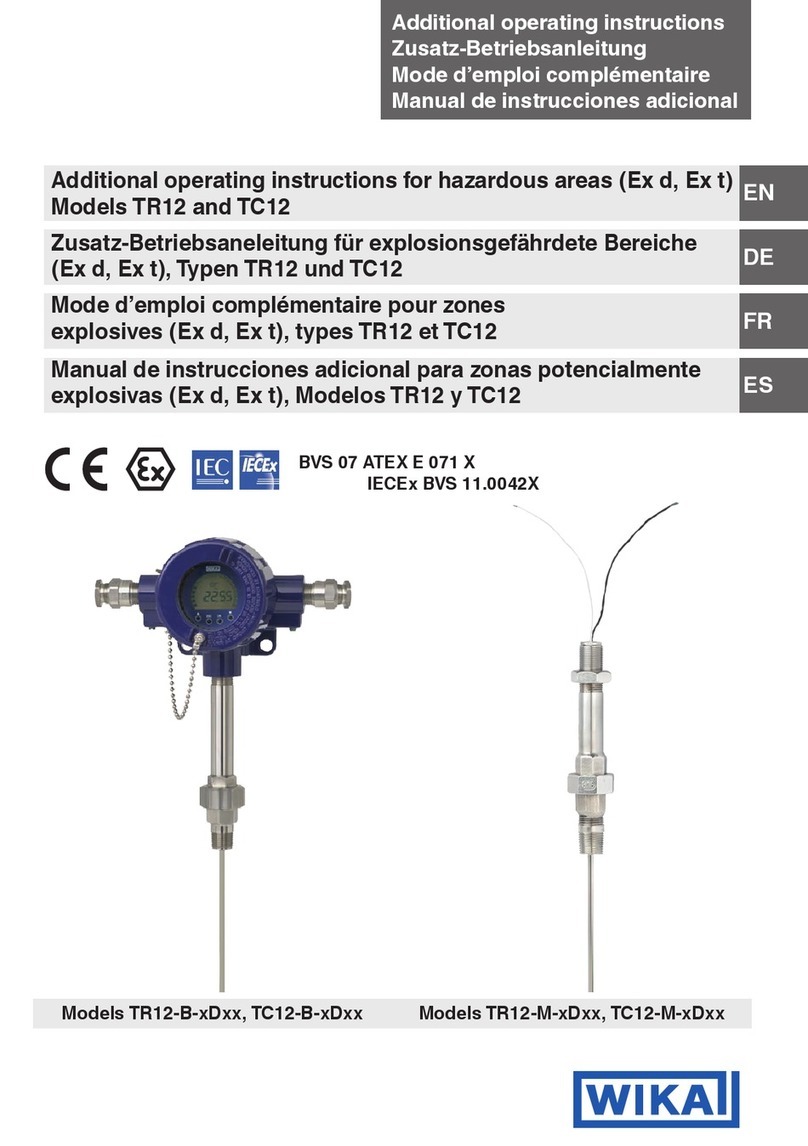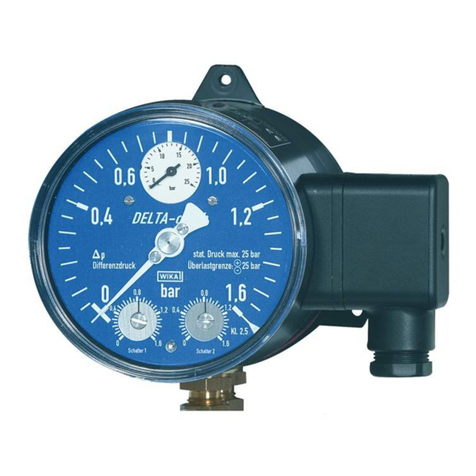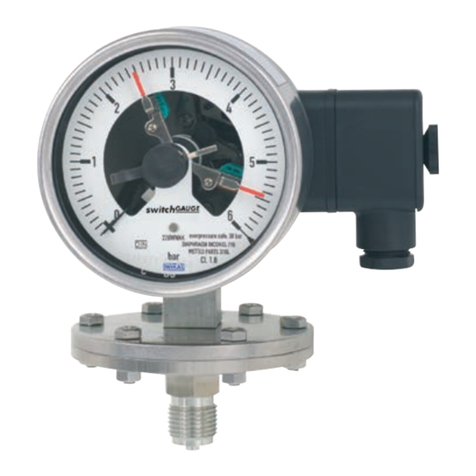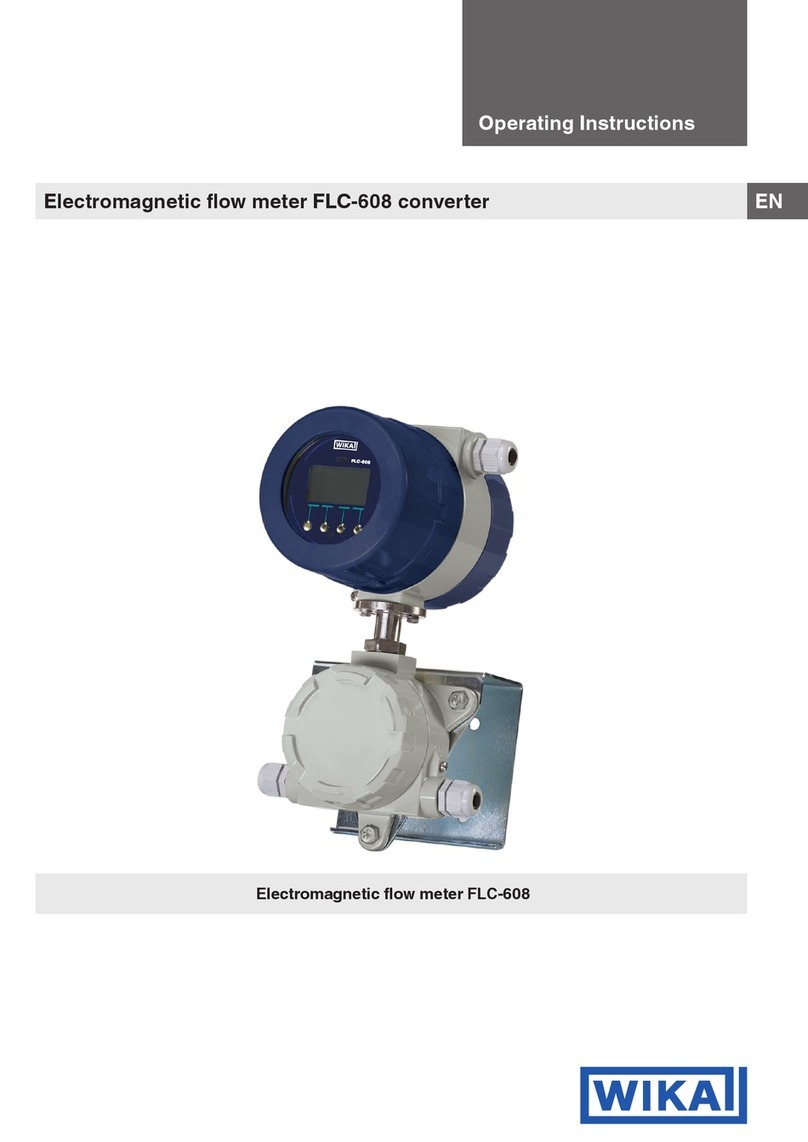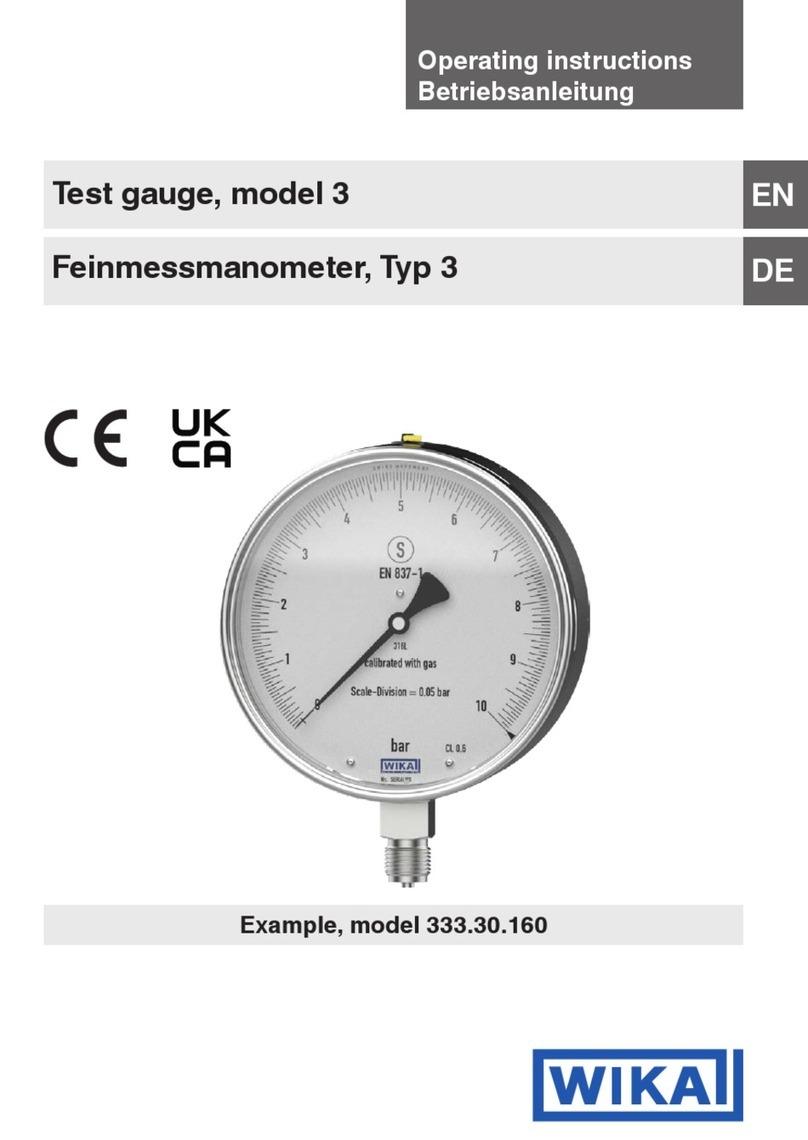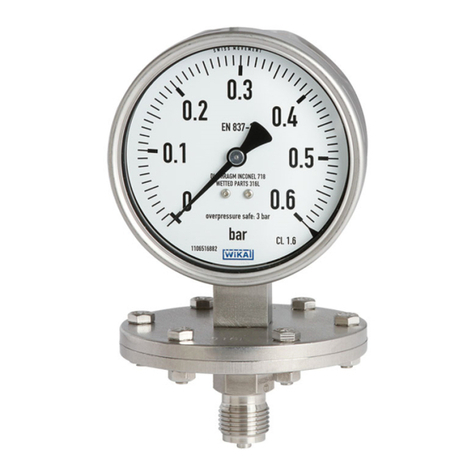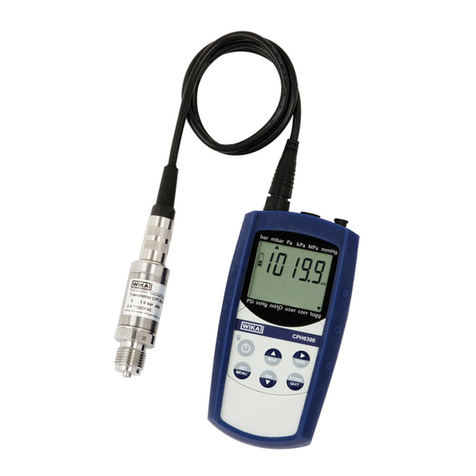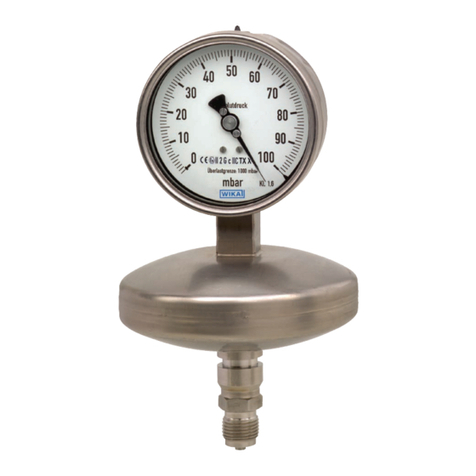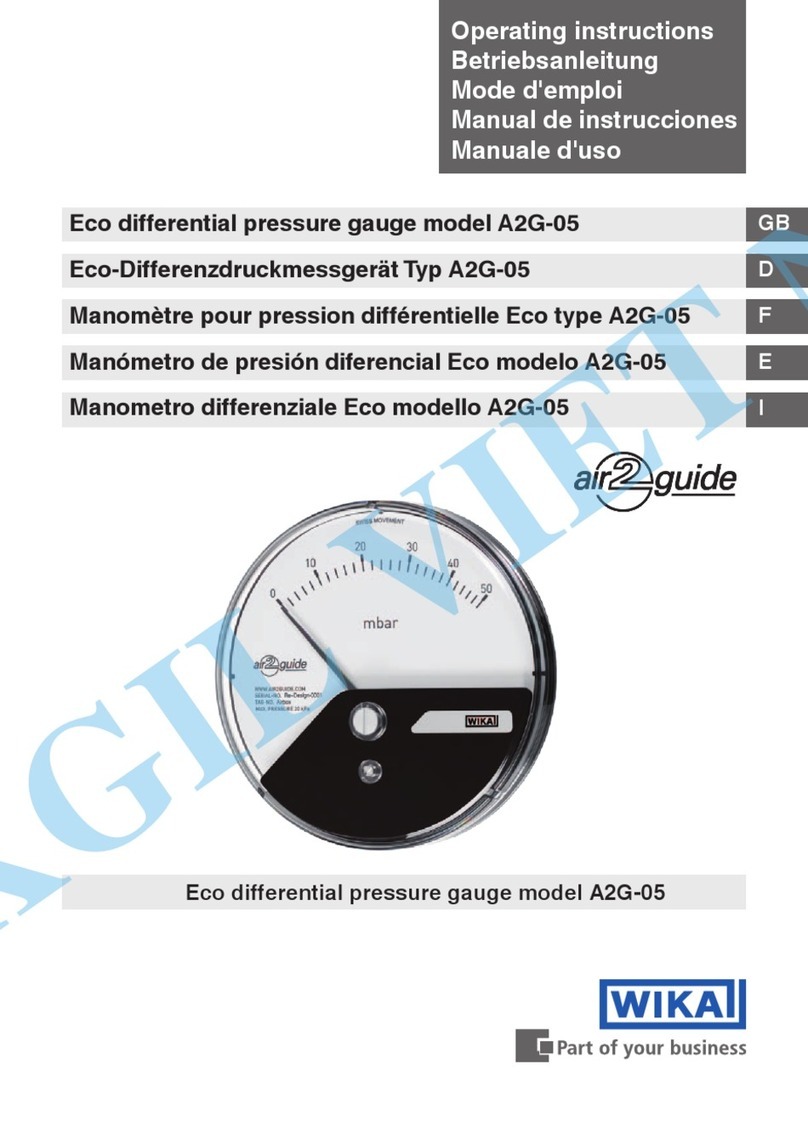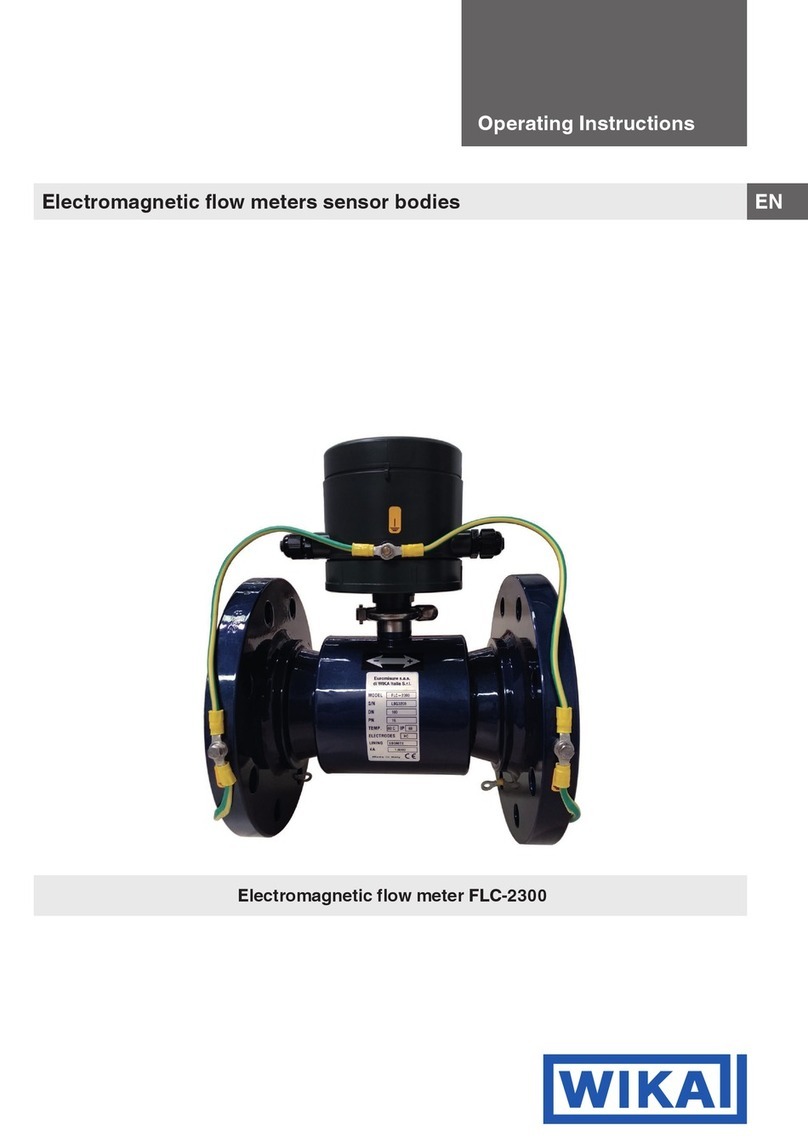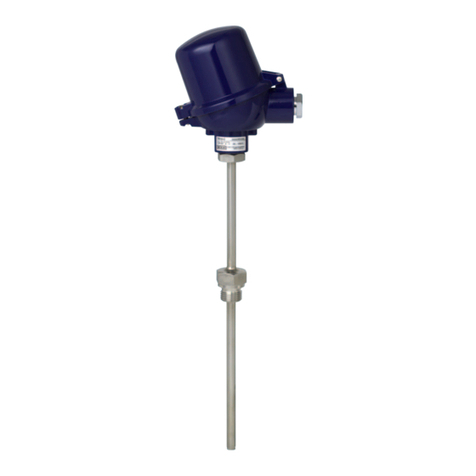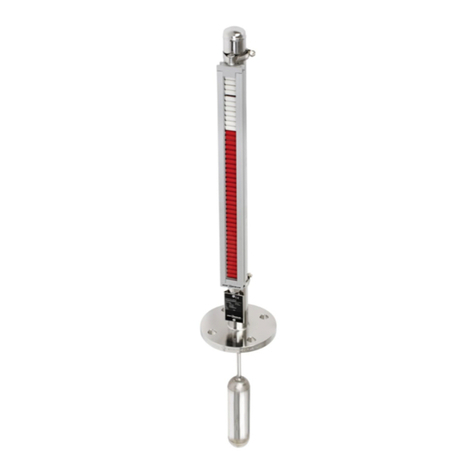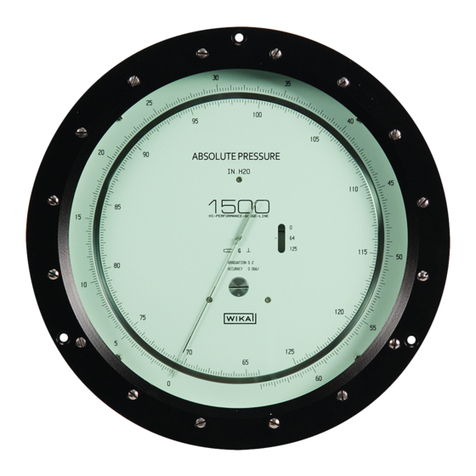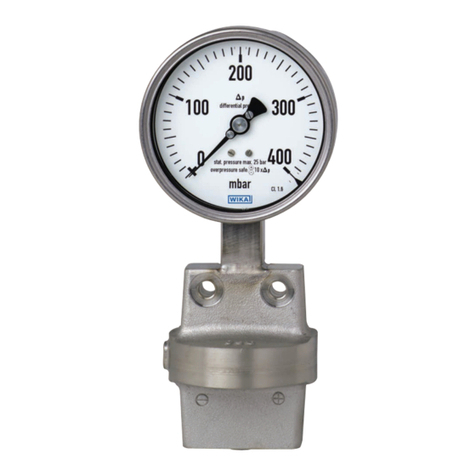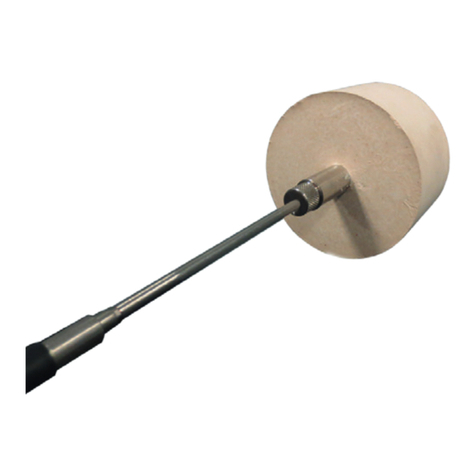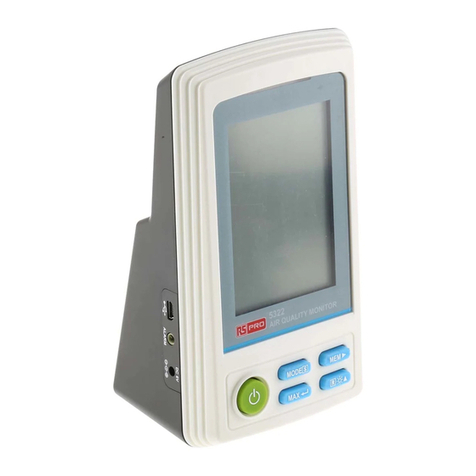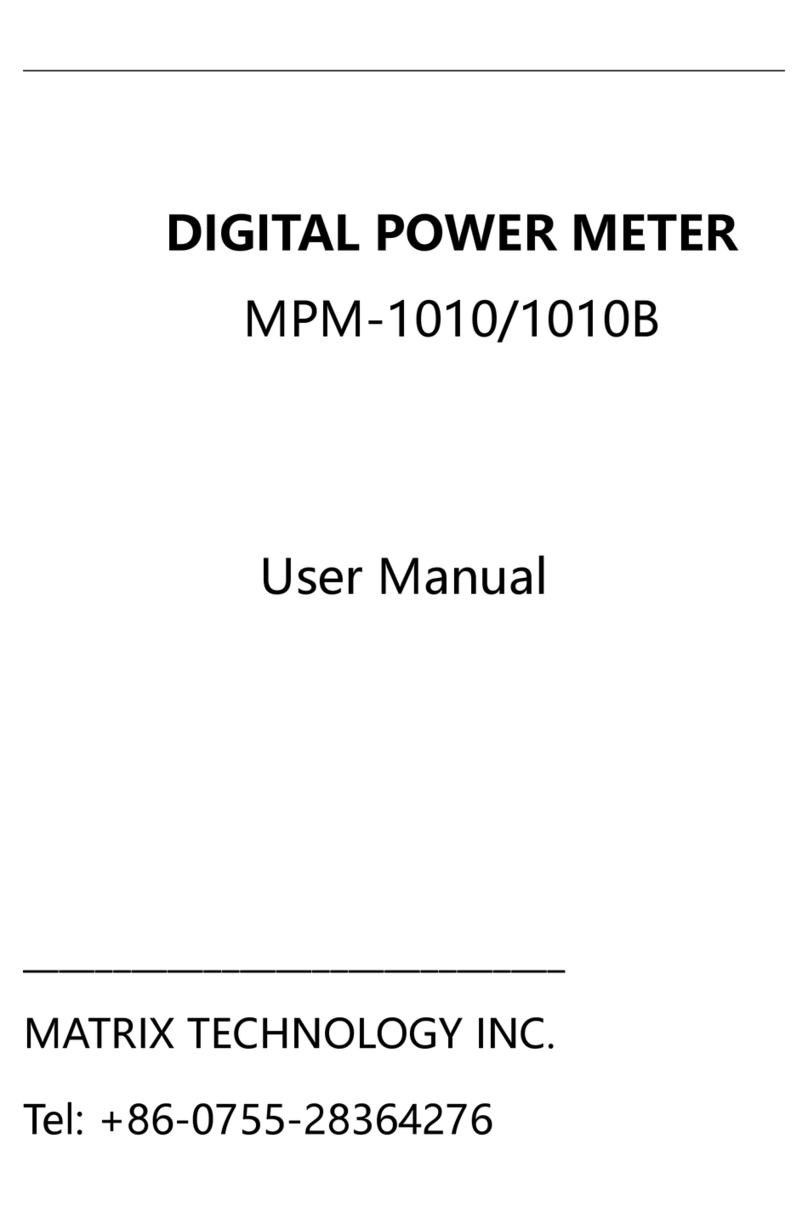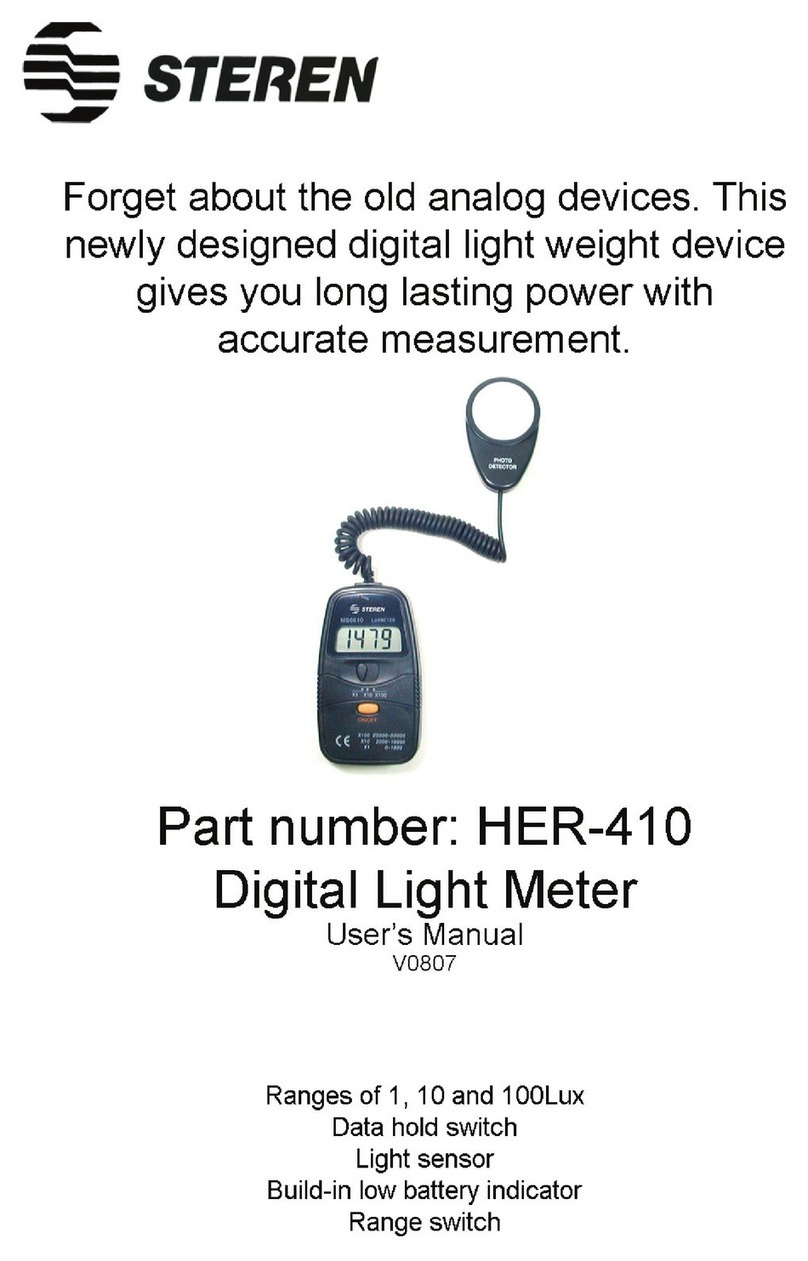WIKA GA11 User manual

Operating instructions
Betriebsanleitung
Mode d‘emploi
Manual de instrucciones
EN
DE
FR
ES
Analysegerät zur Ermittlung der Gasqualität
von Isoliergasen, Typ GA11
Analytic instrument for N2gas
Analytic instrument for determining the quality
of insulated gases, model GA11
Analizador para determinar la calidad del gas
aislante, modello GA11
Instrument d‘analyse pour déterminer la
qualité du gaz isolants , type GA11

2
14395193.01 07/2020 EN/DE/FR/ES
WIKA operating instructions analytic instrument, model GA11
EN
DE
FR
ES
© 07/2020 WIKA Alexander Wiegand SE & Co. KG
All rights reserved. / Alle Rechte vorbehalten.
WIKA®is a registered trademark in various countries.
WIKA®ist eine geschützte Marke in verschiedenen Ländern.
Prior to starting any work, read the operating instructions!
Keep for later use!
Vor Beginn aller Arbeiten Betriebsanleitung lesen!
Zum späteren Gebrauch aufbewahren!
Lire le mode d'emploi avant de commencer toute opération !
A conserver pour une utilisation ultérieure !
¡Leer el manual de instrucciones antes de comenzar cualquier trabajo!
¡Guardar el manual para una eventual consulta!
Betriebsanleitung Typ GA11 Seite 39 - 74
Operating instructions model GA11 Page 3 - 38
Manual de instrucciones modello GA11 Página 111 - 145
Mode d‘emploi type GA11 Page 75 - 110

3WIKA operating instructions analytic instrument, model GA11
EN
14395193.01 07/2020 EN/DE/FR/ES
Contents
Contents
1. General information 5
2. Design and function 6
2.1 Overview. . . . . . . . . . . . . . . . . . . . . . . .6
2.2 Description . . . . . . . . . . . . . . . . . . . . . . .7
2.3 Scope of delivery . . . . . . . . . . . . . . . . . . . . .8
3. Safety 8
3.1 Intended use . . . . . . . . . . . . . . . . . . . . . .8
3.2 Personnel qualification . . . . . . . . . . . . . . . . . . 10
3.3 Personal protective equipment . . . . . . . . . . . . . . . 10
3.4 Handling of insulating gases and gas mixtures . . . . . . . . . . 11
3.5 Valid standards and directives . . . . . . . . . . . . . . . 12
3.6 Dealing with pressure-retaining components . . . . . . . . . . 13
3.7 Residual risks . . . . . . . . . . . . . . . . . . . . . 13
3.8 Labelling, safety marks . . . . . . . . . . . . . . . . . . 13
4. Transport, packaging and storage 14
4.1 Transport. . . . . . . . . . . . . . . . . . . . . . . 14
4.2 Packaging . . . . . . . . . . . . . . . . . . . . . . 14
4.3 Storage . . . . . . . . . . . . . . . . . . . . . . . 14
5. Commissioning, operation 14
5.1 Battery/mains operated . . . . . . . . . . . . . . . . . . 14
5.2 Connecting the gas compartment . . . . . . . . . . . . . . 15
5.2.1 Pumping back in the measured gas compartment . . . . . . . 15
5.2.2 Pumping back in external gas compartment (pressurised) . . . . 16
5.2.3 Pumping back in external gas compartment (depressurised) . . . 16
5.3 Switching on and off . . . . . . . . . . . . . . . . . . . 16
5.4 Performing measurements. . . . . . . . . . . . . . . . . 17
5.5 Cancelling an ongoing measurement . . . . . . . . . . . . . 20
5.6 Emptying depot and depressurised gas compartment . . . . . . . 21
5.7 Saving the measuring result . . . . . . . . . . . . . . . . 22
5.8 Managing the saved measuring results . . . . . . . . . . . . 22
5.8.1 Internal memory . . . . . . . . . . . . . . . . . . 22
6. Settings 24
6.1 Calling the settings mode . . . . . . . . . . . . . . . . . 24
6.2 Settings . . . . . . . . . . . . . . . . . . . . . . . 24
6.3 System . . . . . . . . . . . . . . . . . . . . . . . 25
6.4 Evacuating the system . . . . . . . . . . . . . . . . . . 25
6.5 Importing/exporting the list of measurement names via USB interface . . 27
6.6 Limit values for gases . . . . . . . . . . . . . . . . . . 28
6.7 Firmware upgrade. . . . . . . . . . . . . . . . . . . . 29

4WIKA operating instructions analytic instrument, model GA11
EN
14395193.01 07/2020 EN/DE/FR/ES
Contents
Declarations of conformity can be found online at www.wika.com.
7. Maintenance and cleaning 30
7.1 Maintenance . . . . . . . . . . . . . . . . . . . . . 30
7.2 Cleaning . . . . . . . . . . . . . . . . . . . . . . . 30
7.3 Recalibration . . . . . . . . . . . . . . . . . . . . . 30
8. Replacing sensors 31
9. Faults 33
10. Dismounting, return and disposal 34
10.1 Dismounting . . . . . . . . . . . . . . . . . . . . . 34
10.2 Return . . . . . . . . . . . . . . . . . . . . . . . 34
10.3 Disposal . . . . . . . . . . . . . . . . . . . . . . 35
11. Specifications 36
12. Accessories 37

5WIKA operating instructions analytic instrument, model GA11
EN
14395193.01 07/2020 EN/DE/FR/ES
1. General information
1. General information
■
The analytic instrument described in the operating instructions has been designed
and manufactured using state-of-the-art technology.
All components are subject to stringent quality and environmental criteria during
production. Our management systems are certied to ISO 9001 and ISO 14001.
■
These operating instructions contain important information on handling the
instrument.Working safely requires that all safety instructions and work instructions
are observed.
■
Observe the relevant local accident prevention regulations and general safety
regulations for the instrument's range of use.
■
The operating instructions are part of the product and must be kept in the immediate
vicinity of the instrument and readily accessible to skilled personnel at any time.
■
Skilled personnel must have carefully read and understood the operating instructions
prior to beginning any work.
■
The manufacturer's liability is void in the case of any damage caused by using
the product contrary to its intended use, non-compliance with these operating
instructions, assignment of insuciently qualied skilled personnel or unauthorised
modications to the instrument.
■
The general terms and conditions contained in the sales documentation shall apply.
■
Subject to technical modications.
■
Factory calibrations/DKD/DAkkS calibrations are carried out in accordance with
international standards.
■
Further information:
- Internet address: www.wika.de
- Relevant data sheet: SP 62.11
- Application consultant: Tel.: +49 9372 132-8971
info@wika.com

6WIKA operating instructions analytic instrument, model GA11
EN
14395193.01 07/2020 EN/DE/FR/ES
2. Design and function
2. Design and function
2.1 Overview
Power supply unit
Adapters
Storage for hoses
Storage for power cord
User interface
ON/OFF key
Touchscreen
Network connection (LAN)
Inlet, return pumps
Outlet, gas cylinder
Power and charging
indicators
Outlet for gas recovery bag
USB interface
Power connection

7WIKA operating instructions analytic instrument, model GA11
EN
14395193.01 07/2020 EN/DE/FR/ES
2. Design and function
2.2 Description
Data processing and data storage
The analytic instrument model GA11 is a multi-sensor system for examining the quality
of N2 / CleanAir / DryAir, e.g. in switchgear.The basic instrument consists of a built-in
computer with touchscreen for processing and storage of up to 500 data records.The
data records can be exported via the integrated USB interface.
Extendable sensor system
The sensor system of GA11 is module-based and can be extended. In addition, there
is the possibility of storing measuring gas internally as well as pumping it back into the
original gas compartment without losses after the measurement.
Automatic adjustment of the gas quality
After the measurement, the results will be compared with customer-specically
adjustable limit values according to e.g. CIGRE B3.02.01 or IEC 60480 standards.The
operator thus obtains a reliable statement on whether the insulating gas is suitable for
the given application or not, or whether it is necessary to perform a gas processing or
a gas exchange. For gas mixtures based on N2 / CleanAir / DryAir, there might not yet
be any standards or limit values available. It is recommended that, before measuring
the gas quality, the requirements and the limit values are veried with the respective
manufacturer.
Battery life
If the lithium-ion rechargeable battery is fully charged, the analytic instrument can
perform at least 5 measurements with the “pumping back” function.The number of the
battery-powered pump-back cycles is largely dependent on the container pressure of the
gas to be measured.
The GA11 sends a warning message on the display when battery is low.
If the instrument is not connected to the mains in time, it will shut down automatically in
order to prevent damages and data loss. In the mains operation, the battery is charged
and the instrument can be switched on again at the same time and operate without
restrictions.
Power and charging indicators
The front control panel has two LEDs which indicate the charging status (red) or mains
operation (green).
If an error occurs during the charge cycle, the charging indicator ashes (red).

8WIKA operating instructions analytic instrument, model GA11
EN
14395193.01 07/2020 EN/DE/FR/ES
2. Design and function/3. Safety
2.3 Scope of delivery
■
Analytic instrument model GA11 in a sturdy transport case
■
Power supply unit with power cord
■
Gas emission adapter
■
Calibration certicate
■
Touchpen
■
USB stick
■
Operating instructions
■
See delivery note for optionally ordered sensor system and accessories
Cross-check scope of delivery with delivery note.
3. Safety
Explanation of symbols
WARNING!
... indicates a potentially dangerous situation that can result in serious injury
or death, if not avoided.
CAUTION!
... indicates a potentially dangerous situation that can result in light injuries
or damage to property or the environment, if not avoided.
Information
... points out useful tips, recommendations and information for ecient and
trouble-free operation.
3.1 Intended use
The GA11 is used for determining the gas quality of the following insulating gases and
gas mixtures.
Permissible insulating gases and gas mixtures for N2-Analyser
■
N₂ / CleanAir / DryAir

9WIKA operating instructions analytic instrument, model GA11
EN
14395193.01 07/2020 EN/DE/FR/ES
3. Safety
Application areas
The instrument is especially designed for applications that full the following conditions:
■
The use is only allowed in buildings or dry surroundings.
■
Use only for commercial purposes and in industrial environment.
■
The height of the operation site should not exceed 2,500 m.
■
Environment with max. pollution degree of 3.
■
Voltage supply of overvoltage category II.
■
Ambient temperature between 0 ... 40 °C.
Only use the analytic instrument in applications that lie within its technical performance
limits (e.g. max. ambient temperature, pressure ranges, ...).
→ Performance limits see chapter 11 “Specications”.
The instrument has been designed and built solely for the intended use described here,
and may only be used accordingly.
Only use the instrument with original accessories from WIKA.
Refrain from unauthorised modications to the instrument.
Any use beyond or dierent to the intended use is considered as improper use.
The technical specications contained in these operating instructions must be
observed. Improper handling or operation of the instrument outside of its technical
specications requires the instrument to be taken out of service immediately and
inspected by an authorised WIKA service engineer.
Handle electronic precision measuring instruments with the required care (protect from
humidity, impacts, strong magnetic elds, static electricity and extreme temperatures,
do not insert any objects into the instrument or its openings). Plugs and sockets must be
protected from contamination.
The manufacturer shall not be liable for claims of any type based on operation contrary
to the intended use.

10 WIKA operating instructions analytic instrument, model GA11
EN
14395193.01 07/2020 EN/DE/FR/ES
3. Safety
3.2 Personnel qualification
WARNING!
Risk of injury should qualication be insucient
Improper handling can result in considerable injury and damage to property.
■
The activities described in these operating instructions may only be
carried out by skilled personnel who have the qualications described
below.
■
Keep unqualied personnel away from hazardous areas.
Trained personnel
The plant operator must ensure that the handling of N2/ CleanAir / DryAir (gas
mixtures) is only carried out by a qualied company or by qualied persons which
have been specially trained in accordance with IEC 62271-4:2013, IEC 60480 and
IEC 60376 section 10.3.1 (as well as the Annexes A and B). In addition, it is imperative
that personnel are familiar with the physical principles of N2/ CleanAir / DryAir
(gas mixtures) and have the specic knowledge to perform gas handling and gas
measurements from IEC 62271-4:2013, ASTM D2029 - 97:2017 and the CIGRÈ - SF₆
Measurement guide (723).
Special operating conditions require further appropriate knowledge, e.g. of aggressive
media (ASTM D2284 – 11).
3.3 Personal protective equipment
The personal protective equipment is designed to protect the skilled personnel from
hazards that could impair their safety or health during work.When carrying out the
various tasks on and with the instrument, the skilled personnel must wear personal
protective equipment.
Follow the instructions displayed in the work area regarding personal protective
equipment!
The requisite personal protective equipment must be provided by the operating
company.
Wear safety goggles!
Safety goggles to EN 166, class 2.
They protect the eyes from ying parts during coupling or releasing of the
quick connections under pressure.
Wear protective gloves!
Protect hands from friction, abrasion, cuts or deep injuries and also from
contact with hot surfaces.

11WIKA operating instructions analytic instrument, model GA11
EN
14395193.01 07/2020 EN/DE/FR/ES
3. Safety
3.4 Handling of insulating gases and gas mixtures
Similar to uorinated gases for insulation in electrical systems, toxic decomposition
products (e.g. nitrogen oxides) can also arise with nitrogen-based gas mixtures. High
concentrations of nitrogen-based insulating gas escaping from plant can lead to the
permissible workplace limit for certain substances being exceeded.
Properties of insulating gases
■
Colourless and odourless
■
Chemically neutral
■
Inert (only pure nitrogen without oxygen content)
■
No toxicity
■
No damage to the ozone layer
Danger of suocation caused by insulating gases and gas mixtures
High concentrations of gases and gas mixtures may lead to suocation. Nitrogen, in
particular, is suocating in high concentrations without any noticeable signs, since it can
displace oxygen through its enrichment in breathing air. Depending on the duration of
the inhalation and the remaining oxygen concentration in the environment, sleepiness,
sickness, increased blood pressure and shortness of breath occur.
Danger caused by decomposition products
Insulating gas in electrical systems may contain decomposition products generated by
electric arcs:
■
Nitrogen oxides
Decomposition products can be harmful to health.
■
They can cause poisoning by inhalation, ingestion or contact with the skin.
■
They may be irritating to the eyes, the respiratory system or the skin and burn them.
■
Inhalation of large quantities may damage the lungs.
Observe the following safety instructions in order to avoid danger from insulating gas:
■
Wear personal protective equipment.
■
Read the material safety data sheet of the gas supplier.
■
With large leaks, evacuate the area quickly.
■
Ensure good ventilation.
■
Ensure the leak tightness of the equipment with a leak detector (e.g. model GIR-10).

12 WIKA operating instructions analytic instrument, model GA11
EN
14395193.01 07/2020 EN/DE/FR/ES
3. Safety
3.5 Valid standards and directives
The following standards and directives refer to the handling of SF₆ gas.
However, they can still include validity for the correct handling of electrical
equipment and are therefore to be used as guidelines.
Installation, assembly, commissioning:
■
DGUV Information 213-013 (SF₆ systems and equipment)
■
IEC 62271-4:2013 (High-voltage switchgear and controlgear - Part 4: Handling
procedures for sulphur hexauoride (SF₆) and its mixtures)
■
IEC 60376:2018 (Specication of technical grade sulphur hexauoride (SF₆) and
complementary gases to be used in its mixtures for use in electrical equipment)
■
IEC 60480 (Specications for the re-use of sulphur hexauoride (SF₆) and its
mixtures in electrical equipment)
■
CIGRE report 276, 2005 (Guide for the preparation of customised “Practical SF₆
handling instructions”)
Leaks during operation:
■
IEC 60376:2018 (Specication of technical grade sulphur hexauoride (SF₆) and
complementary gases to be used in its mixtures for use in electrical equipment)
■
IEC 60480 (Specications for the re-use of sulphur hexauoride (SF₆) and its
mixtures in electrical equipment)
■
CIGRE 2002 (“SF₆ gas in the electrical industry”)
Repair work and maintenance:
■
IEC 62271-4:2013 (High-voltage switchgear and controlgear - Part 4: Handling
procedures for sulphur hexauoride (SF₆) and its mixtures)
■
CIGRE 1991 (Handling of SF₆ and its decomposition products in Gas Insulated
Switchgear (GIS))
■
CIGRE report 276, 2005 (Guide for the preparation of customised “Practical SF₆
handling instructions”)
■
CIGRE report 163, 2000 (Guide for SF₆ gas mixtures)
Insulating gas is a colourless and odourless, chemically neutral, inert, not
toxic and not harmful to the ozone layer. Detailed information is given in IEC
60376 and IEC 61634.

13WIKA operating instructions analytic instrument, model GA11
EN
14395193.01 07/2020 EN/DE/FR/ES
3. Safety
3.6 Dealing with pressure-retaining components
Pneumatic energy can lead to serious injury.
With damaged individual components, highly pressurised air can escape and cause eye
injuries, for example.
Pressure-retaining components (e.g. adapters, hoses and external containers) may
burst due to overpressure.
Observe the following safety instructions in order to avoid danger from pneumatic
energy:
■
Depressurise the instrument before starting any work on it. Be careful of the
accumulator, and ensure it is fully discharged.
■
Do not alter the pressure settings above the maximum permissible levels.
■
Make sure that all pressure-retaining components are designed for the quoted
nominal pressures (→ see chapter 11 “Specications”).
3.7 Residual risks
Despite compliance with all relevant safety regulations for the design and construction
of our instruments as well as intended use of them by the operator, residual risks may
occur during operation.
Residual risks are described in detail in the individual chapters. It is vital that you comply
with all safety instructions.
3.8 Labelling, safety marks
Product label (example)
The product label is located at the rear of the display frame.
Product designation (model)
Supply voltage
Serial number
Date of manufacture
WIKA
Alexander Wiegand SE & Co. KG, 63911 Klingenberg, Germany
Product:
Power Supply:
Serial No:
Manufacturing Year:
Made in Germany

14 WIKA operating instructions analytic instrument, model GA11
EN
14395193.01 07/2020 EN/DE/FR/ES
4. Transport, packaging and storage / 5. Commissioning, ...
4. Transport, packaging and storage
4.1 Transport
Check the analytic instrument for any damage that may have been caused by transport.
Obvious damage must be reported immediately.
4.2 Packaging
Do not remove packaging until just before mounting.
Keep the packaging as it will provide optimum protection during transport (e.g.
calibration, sending for repair).
4.3 Storage
Permissible conditions at the place of storage:
Storage temperature: -20 ... +60 °C
Air humidity: 15 ... 90 % r. h. (non-condensing)
Avoid exposure to the following factors:
■
Direct sunlight or proximity to hot objects
■
Mechanical vibration, mechanical shock (putting it down hard)
■
Soot, vapour, dust and corrosive gases
■
Hazardous environments, ammable atmospheres
■
Storage outdoors or in humid environment
■
Unauthorized access
5. Commissioning, operation
Depending on the version of the analytic instrument, the user interface may
dier from those illustrated in these operating instructions. However, the
procedure is always the same.
5.1 Battery/mains operated
The analytic instrument can be operated in battery mode and in the mains supply.
If the lithium-ion rechargeable battery is fully charged, the analytic instrument can
perform at least 5 measurements with the “back pumping” function.The number of the
battery-powered pump-back cycles is largely dependent on the container pressure of the
gas to be measured.
The GA11 sends a warning message on the display when battery is low.
If the instrument is not connected to the mains in time, it will shut down automatically in order
to prevent damages and data loss.In the mains operation, the battery is charged and the
instrument can be switched on again at the same time and operate without restrictions.

15WIKA operating instructions analytic instrument, model GA11
EN
14395193.01 07/2020 EN/DE/FR/ES
5. Commissioning, operation
Establishing connection to mains supply
1. Connect power supply unit to the power cord.
2. Connect power supply unit to mains connection on the operating panel.
3. Connect the power cord to the socket.
⇒Connection to mains supply is established.
5.2 Connecting the gas compartment
CAUTION!
Escaping gas results in environmental hazards
If there are leakages at the connecting elements, the environmentally
hazardous gas may be released to the atmosphere.
▶Make sure that there is no leakage at any connections (e.g. by using gas
detector GIR-10)
For an optimal measuring result, evacuate the connecting hose before the measurement.
To perform a measurement, the pressure of the gas compartment to be measured must
be at least 1.3 bar abs.. If the inlet pressure is below 1.3 bar abs., it is possible to use an
inlet pressure control unit (e.g. model GA05) to raise the pressure.
5.2.1 Pumping back in the measured gas compartment
▶Connect “Inlet, return pumps ” to the gas compartment.
⇒Gas compartment is connected.
During pumping back, the gas is pumped back into the gas compartment via the “Inlet,
return pumps ”.

16 WIKA operating instructions analytic instrument, model GA11
EN
14395193.01 07/2020 EN/DE/FR/ES
5. Commissioning, operation
5.2.2 Pumping back in external gas compartment (pressurised)
Requirement:
The lling pressure of the external gas compartment is between 1.3 ... 12 bar abs.
1. Connect “Inlet, return pumps ” to the gas compartment to be measured.
2. Connect “Outlet for gas cylinder ” to the external gas compartment.
⇒Gas compartment is connected.
5.2.3 Pumping back in external gas compartment (depressurised)
1. Connect “Inlet, return pumps ” to the gas compartment to be measured.
2. Connect “Outlet for gas recovery bag ” to the external gas compartment.
⇒Gas compartment is connected.
5.3 Switching on and off
Switching on
▶Press On/Off switch.
⇒A self-test is performed.
⇒The residual gas is filtered.
⇒Instrument is ready for operation.
⇒Start screen with sensor values is displayed (the actual display may vary from the
example).
Switching o
▶Press the following button.
▶

17WIKA operating instructions analytic instrument, model GA11
EN
14395193.01 07/2020 EN/DE/FR/ES
5. Commissioning, operation
5.4 Performing measurements
1. Press “Measurement”.
2. Congure the measuring methods and press “Start” to conrm.
⇒The measurement begins.
Interim pumping of the gas back into the same gas compartment between
two measurements can cause a change in the gas quality.With several
measurements with interim pumping back, the measuring results with
respect to moisture of the gases can deviate from each other. For an optimal
measuring result, the gas should only be returned to the gas compartment
after all measurement processes have been completed.
Measurement
Data
management
Settings

18 WIKA operating instructions analytic instrument, model GA11
EN
14395193.01 07/2020 EN/DE/FR/ES
5. Commissioning, operation
3. Save or skip the measuring result.
Measuring results are automatically compared with the dened limit values and an
OK symbol is displayed if they pass.
Dene limit values (→see chapter 12 “Accessories”).
Measurement without internal depot
The measuring gas will be directly released into the atmosphere after the measurement. For
this, connect the supplied adapter to port 3.
CAUTION!
Physical injuries
Improper release of measuring gas may result in personal injury.
▶Do not direct the hose end towards the face.
Measurement with internal depot
The measuring gas will be stored temporarily in the internal depot and later be pumped
back into the gas compartment to be measured or a pressurised external gas compartment.
Due to the high gas ow velocity of N₂, the measuring time may have to be reduced. The
measurement with internal depot is only recommended if the measurement cannot be
performed without an internal depot.
Measurement with external container (depressurised)
The measuring gas will be directly pumped into a depressurised external gas compartment
(e.g. gas recovery bag, model GA45).
Pumping back after the measurement
Once the measurement is nished, a selection window will open, which enables the
selection of the storage location.

19WIKA operating instructions analytic instrument, model GA11
EN
14395193.01 07/2020 EN/DE/FR/ES
5. Commissioning, operation
4. Select the gas compartment for pumping the measuring gas back (only available
when the “pumping back” function is selected).
⇒Measuring gas is pumped back.
⇒Measurement is finished.
Connection
The measuring gas is directly pumped back into the measured gas compartment.
Connection
The measuring gas is pumped into a pressurised external gas compartment (e.g. gas cylinder).
The maximal pumping capacity of the analytic instrument is:
■
10 bar abs. (N₂-Analyser)
External container
With the function activated, the measuring gas is emptied from an external container at
connection as well.

20 WIKA operating instructions analytic instrument, model GA11
EN
14395193.01 07/2020 EN/DE/FR/ES
5. Commissioning, operation
5.5 Cancelling an ongoing measurement
1. Press “Cancel” and conrm by pressing “Yes”.
2. Select the gas compartment for pumping the measuring gas back (only available
when the “pumping back” function is selected).
⇒Measuring gas is pumped back.
⇒Measurement is finished.
Connection
The measuring gas is directly pumped back into the measured gas compartment.
Connection
The measuring gas is pumped into a pressurised external gas compartment (e.g. gas cylinder).
The maximal pumping capacity of the analytic instrument is:
■
10 bar abs. (N₂-Analyser)
Other manuals for GA11
1
Table of contents
Languages:
Other WIKA Measuring Instrument manuals
Popular Measuring Instrument manuals by other brands
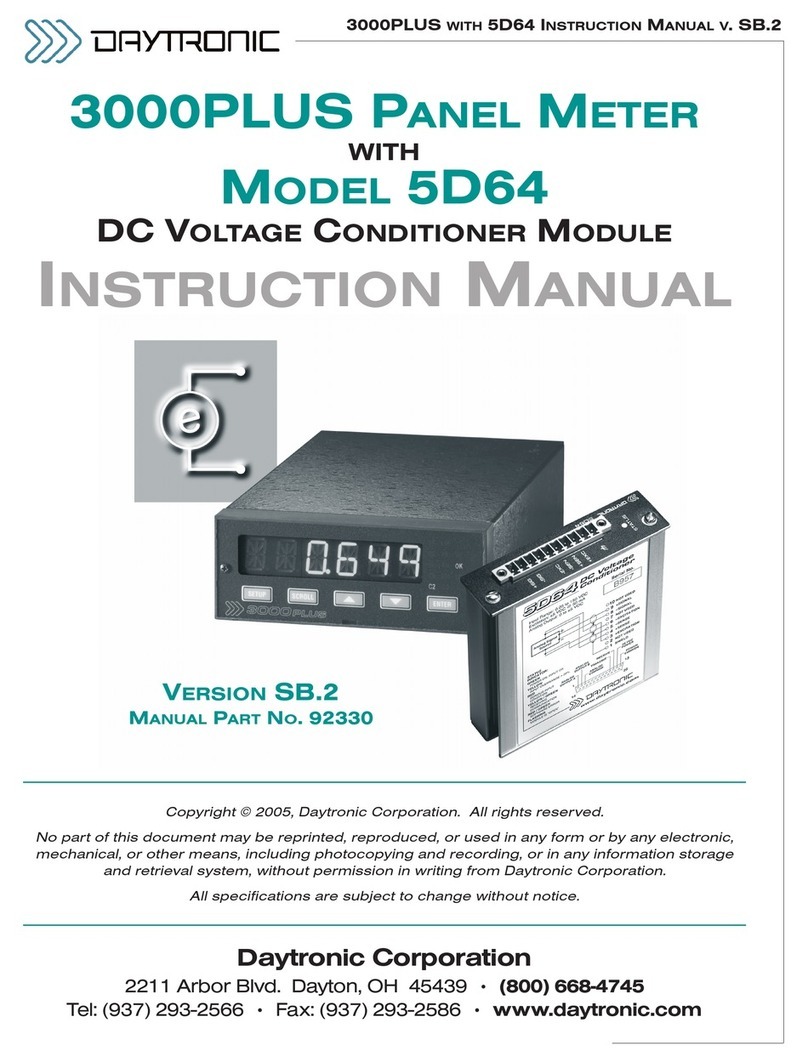
DayTronic
DayTronic 3000PLUS instruction manual
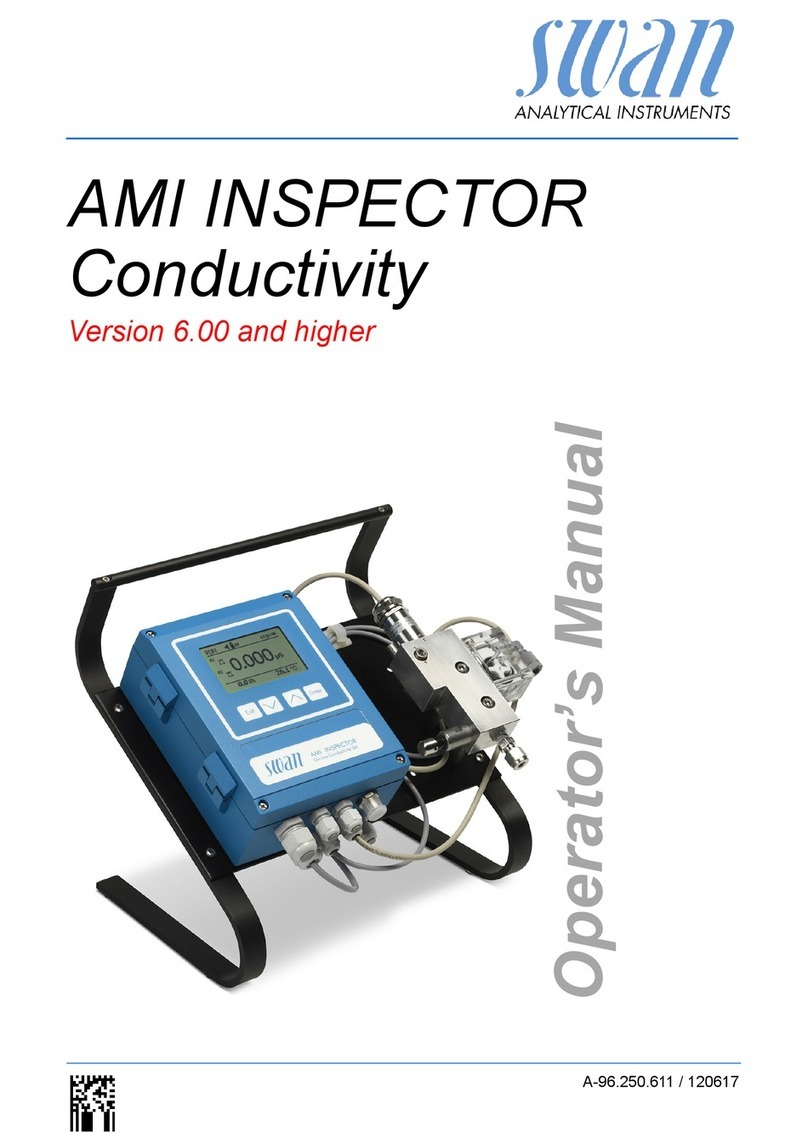
Swan Analytical Instruments
Swan Analytical Instruments AMI INSPECTOR Conductivity Operator's manual

Rohde & Schwarz
Rohde & Schwarz ZVH4 operating manual

MADDALENA
MADDALENA SensoStar C Installation and operating instructions
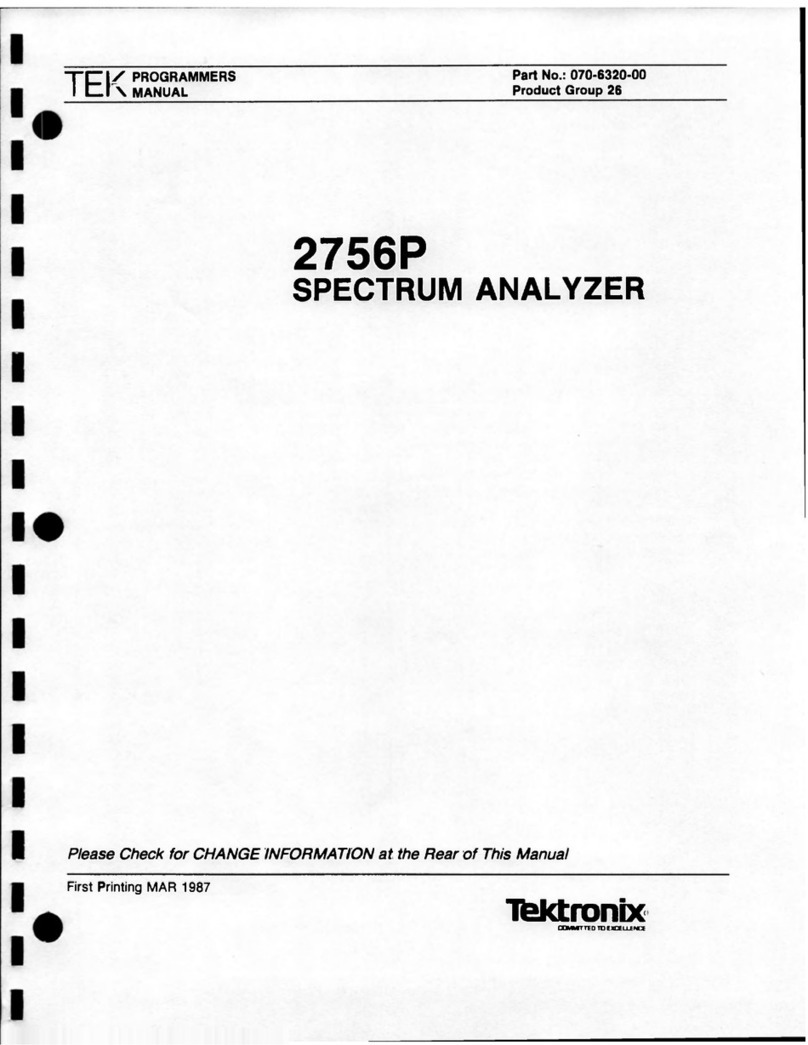
Tektronix
Tektronix 2756P Programmer's manual

Hioki
Hioki 3661-20 instruction manual
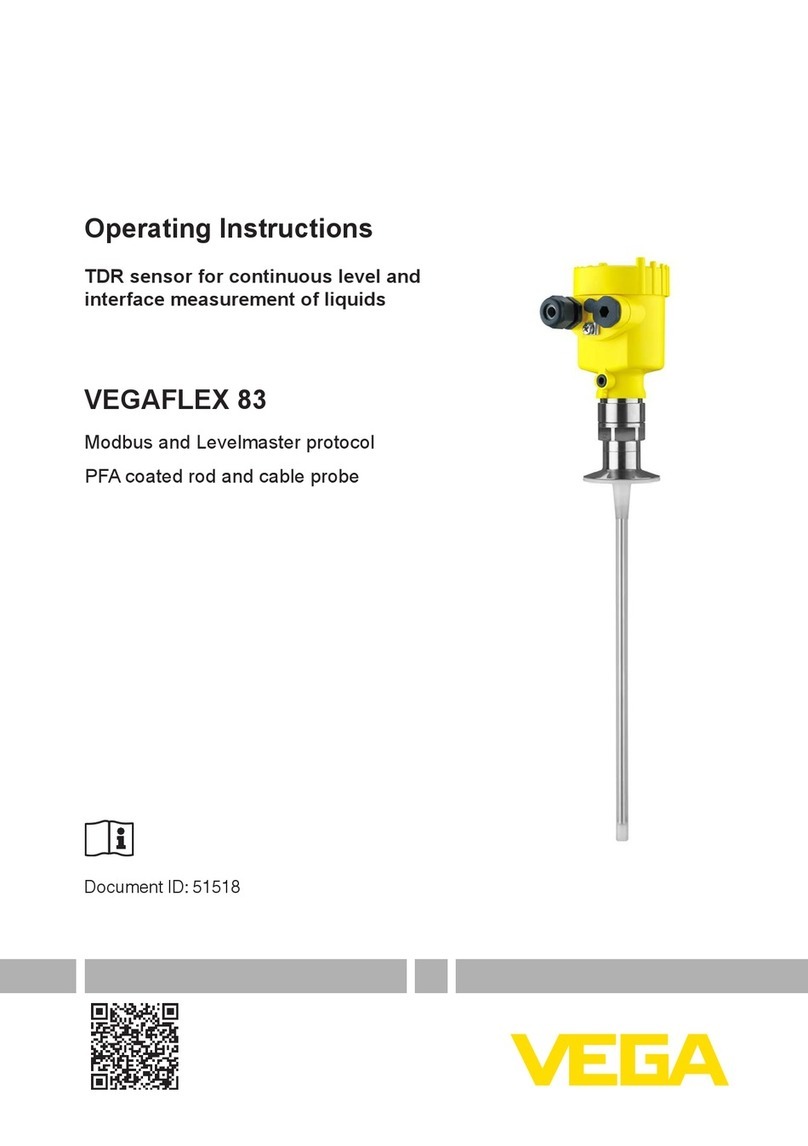
Vega
Vega vegaflex 83 operating instructions
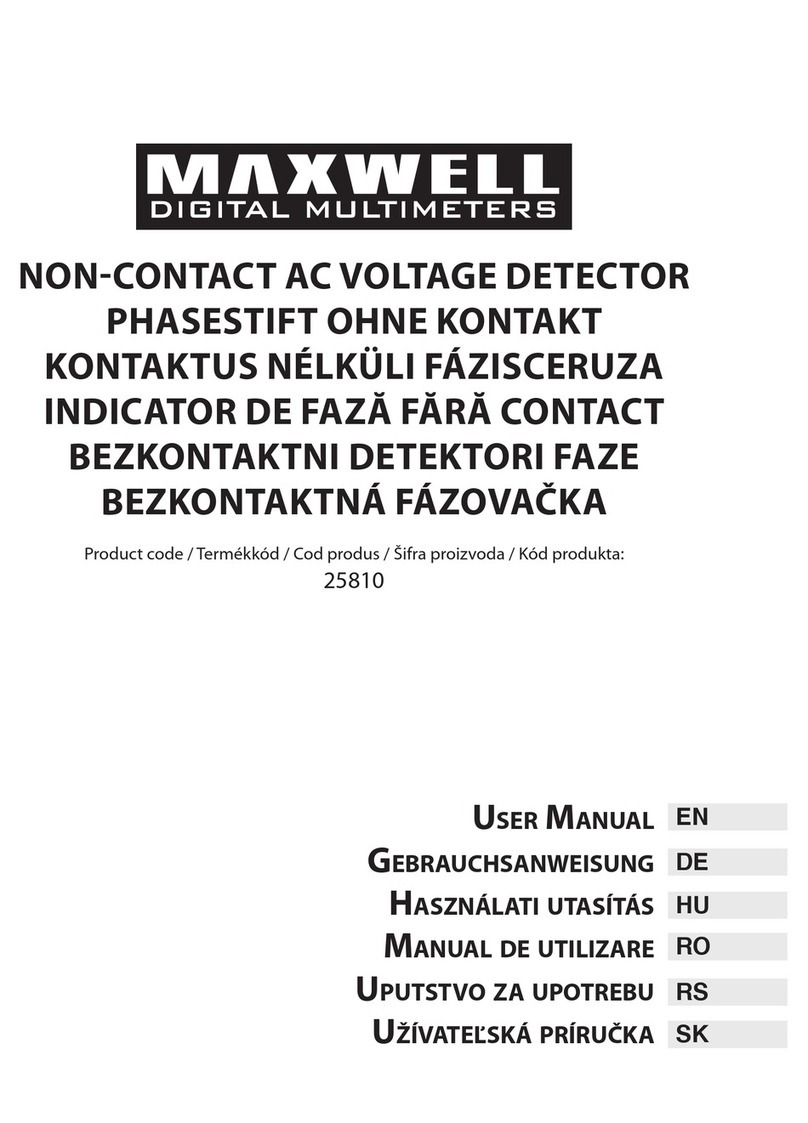
Maxwell Digital Multimeters
Maxwell Digital Multimeters 25810 user manual
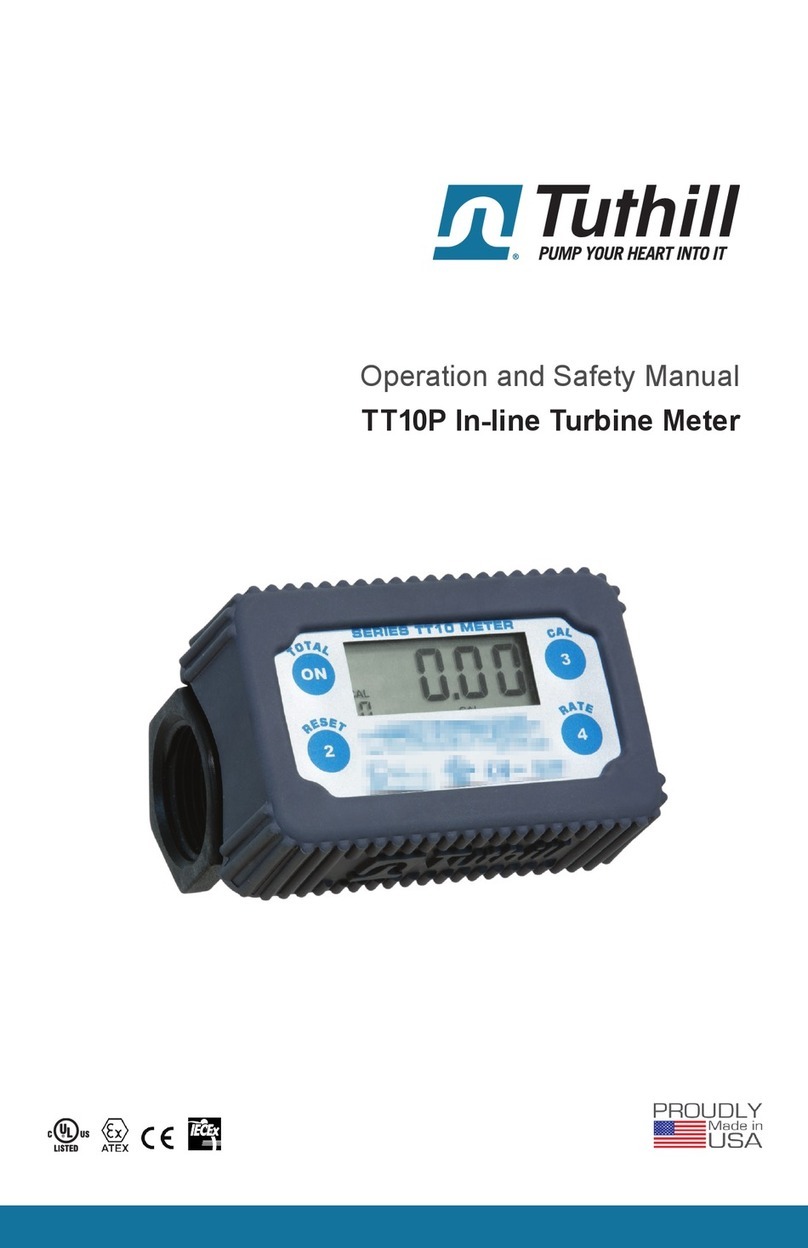
Tuthill
Tuthill TT10P Operation and safety manual

Kolida
Kolida KTS440 Series manual
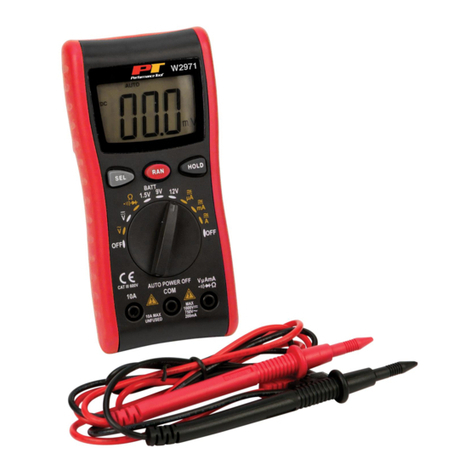
Performance Tool
Performance Tool W2971 owner's manual
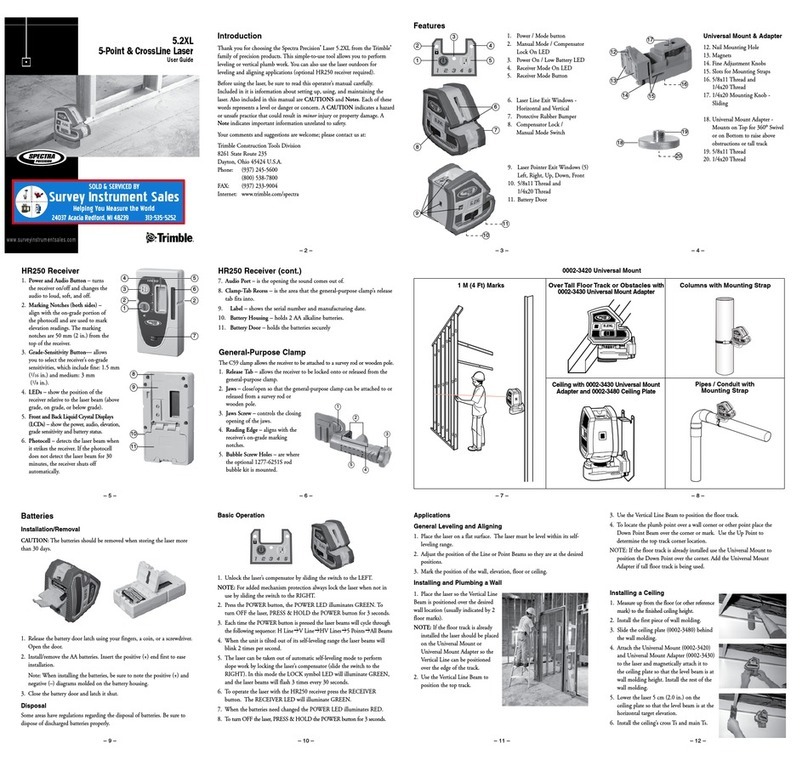
Spectra Precision
Spectra Precision 5.2XL user guide
